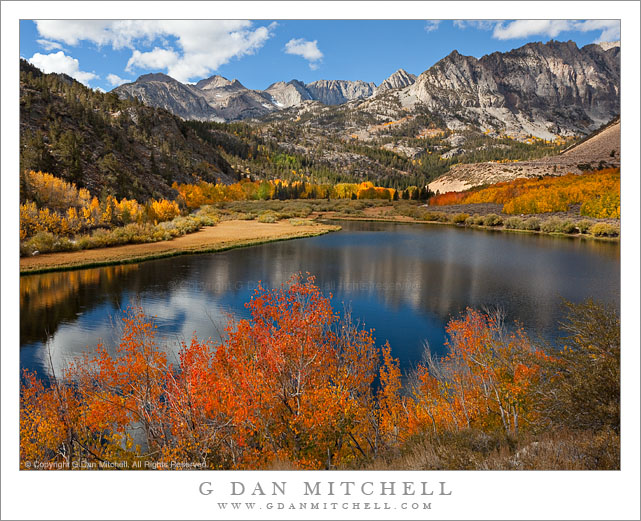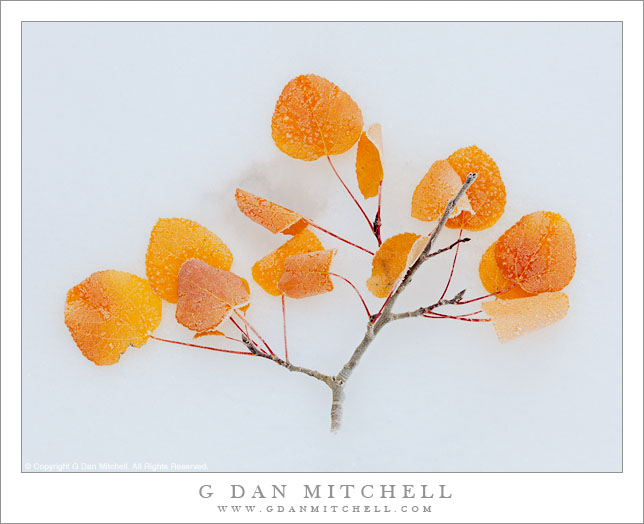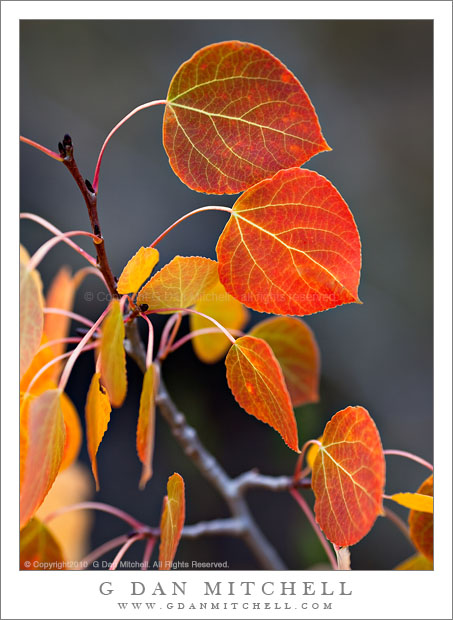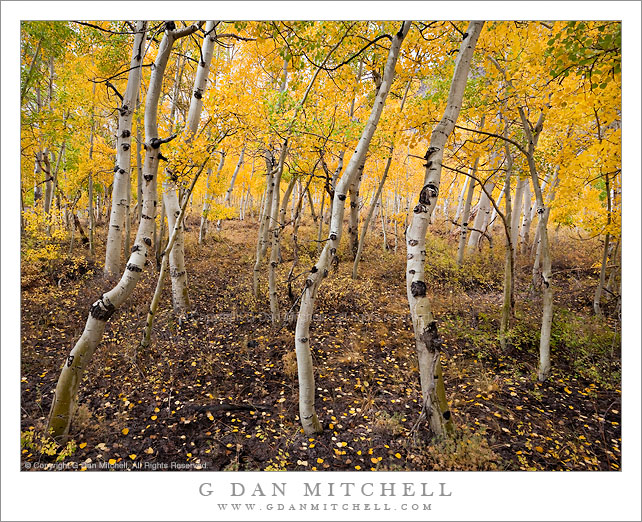As I write this it is mid-September — still summer for a few more days, but the prospect of autumn is definitely in the air here in California. The temperatures have moderated — though we’ll have a few more hot spells — and the first hints of Pacific winter weather fronts are appearing. Sierra Nevada nighttime temperatures dropping in the twenties. A few weeks ago when I was last in the Sierra I spotted a few of the unmistakable first signs of fall: yellow and brown corn lily plants, a few yellow leaves on arctic willow, golden brown meadows, and here and there the odd early yellow aspen leaves.
With all of this happening, it is the right time for an update on Sierra Nevada fall color, particularly the seasonal aspen color which is reportedly already starting.
Since I have already written quite a bit on this subject (including a book!) I will try to keep the length of this year’s new post somewhat shorter than in might be, but I will provide links to a number of earlier articles that are still relevant. And there is that book…
Predictions, Or Not
Every year as the fall aspen season approaches we start to read predictions concerning the evolution of this season and how it may be different. I admit that I am still a bit of a sucker for this, and I will make a few guesses. But over the years I have discovered a few things about the aspen color predictions that make me a bit less certain.
- Lots of folks, including me at times, have been tricked by the first color and imagined that it meant that we would have an early color season.
- In most years, regardless of our take on the evolving conditions, things tend to play out on roughly the same overall schedule. There are some possible variations that I’ll mention, and the extraordinary drought of the past five years did seem to throw things off in a few cases.
- Certain factors do affect the day-to-day progress of the color — wind, cold, snow, rain, elevation, etc — but these are not generally predictable, and we simply have to respond to them as they occur.
Having said that, I do have to note that this season has the potential to at least be different from the past few. I’m not certain at all how that will actually affect the color timing, but clearly we have gone from several years of historically significant drought to a season of historically high precipitation. I do think that we may notice fewer trees under stress — last fall I saw an unusual number of them turn early, simply drop leaves, or even appear to die or go dormant.
Climate change must also have some effect, though I’m not quite sure I see the trends clearly. On one hand we might expect color change to come later as the weather stays warmer as autumn begins. On the other hand, I feel like I have encountered somewhat earlier color change over the past few years.
Bottom line? I have no idea! As always, it is best to target the core of the color season — more on that below — and then to remain as flexible as possible so that you can adapt to evolving conditions.
When To Go?
The simplest answer is perhaps to go about one week into October and hope for the best. Significant color typically begins to appear shortly after October 1, and it usually continues at least through the second week of the month. If this is your first visit to Eastern Sierra autumn aspen color, a week into the month is typically a good bet.
There are ways to stretch the color season a bit further. There always is at least some color before September is over. Since high elevation trees tend to change before those at lower elevations, you might look for groves well up into the east side mountains, possibly hiking up from trailheads to find them. I have also found good color in September by traveling east of the Sierra out into the start of basin and range country.
The color transition tends to work its way from high to low elevations, so you might look for color among the lowest elevation areas after the middle of the month. This can take you down near the base of the range on the east side, and at this point the aspen colors can be complemented by cottonwoods and other trees, too.
Where to go?
There are some “classic” places to go to look for Eastern Sierra aspens. I’ll mention the general locations of some of these, but I am not going to provide a list of “The Ten Best Aspen Spots In The Sierra” or “Where I Made That Photograph.” I have my reasons.
- I want others to have the same great experience that I had by poking around and discovering my own special places — not just go to where someone tells you to go.
- Over the past decade, as more and more photographers and others have sought out the aspen color, some areas have been negatively impacted by the crowds.
- Along the same lines, you probably don’t want to go all the way up there only to find yourself in a spot that is so crowded that you cannot park your car!
- You don’t need to know The Best Spots — basically there are aspens everywhere and you can usually spot them pretty easily.
But I will name a couple of obvious (and accessible and popular) areas to get you started, though I’ll point to general areas and not, for example, specific groves or lakes. When you get to these areas, have fun looking around!
Here are two.
- The Bishop Creek drainage above the town of Bishop is popular and has trees across a wide range of elevations, making it a good prospect throughout most of the color season. Proximity to Bishop is useful if you plan to stay in a motel or go out to eat. Basically, take the main road east out of town, head up into the mountains, and explore.
- The June Lakes Loop is west of US 395 between Lee Vining and Mammoth Lakes. There is plenty of color right along this popular route, and since the elevation is a bit lower here it can be better slightly later in the season.
What about other locations? Here I offer ideas on how to find your own aspens rather than pointing you at specific locations. Again, there is great color everywhere, so have at it and enjoy the search!
A drive along US 395 almost anywhere between the Lake Tahoe area and Bishop will take you past mountains where you’ll spot colorful trees — usually on the west side of the road in the Sierra, but sometimes to the east.
Every trans-Sierra pass south of Lake Tahoe has aspens that you cannot miss. If you want to avoid Tahoe, consider the roads over Carson, Ebbetts, Sonora, and (with qualifications) Tioga Passes. The main show is usually east of passes, but on all except Tioga you can also find some good trees on the west side of the crest, too. (There are aspens in Yosemite, but not very many along Tioga Pass Road west of the pass.) Also consider a few other routes, including Monitor Pass between the Ebbetts Pass route and US 395.
For those who are willing to search a bit further afield, there are aspens east of the Sierra Nevada, too. If you don’t mind exploring some of the less traveled country out that direction you may find some good color and some solitude.
How To Photograph Aspen Color
That is a very big subject — too big for this post, and perhaps even something you’ll continue to learn about for years. But here are a few thoughts and ideas.
- Early and late-day light are often the most interesting. Get up at or before dawn and you be rewarded. Don’t leave until it is too dark to photograph.
- Midday light is often flat and harsh — you can photograph in it, but it isn’t easy. However, clouds can improve things, whether they are spectacular clouds against a blue sky or thin clouds that soften the light a bit.
- Aspen color can appear flat and uninteresting when the trees are front lit — in other words, when the light is directly behind you. The colors are often more interesting when the light is coming from the other side of the trees.
- If you can photograph in early morning or evening shade, this light can be soft and fill in the shadows, reducing the harsh effect of midday light. The light in these conditions can be somewhat blue, and you may have to adjust for that later.
- Consider all of the ways that you can photograph this subject — individual leaves (on the trees or on the ground), bare trunks and branches once leaves have fallen, whole groves with riotous color, the landscape with the colorful trees as just one component, creeks and lakes, and more.
- As with so many things, what you leave out of your photograph can be just as important as what you exclude. Focus on your primary subject and consider moving closer to eliminate elements that may distract.
- If you have control over your camera settings, you may want to reduce exposure just a bit when photographing bright leaf colors to avoid “blowing out” the brightest elements.
- If you aspire to serious photography and aren’t already using one, consider a tripod and remote release. Not only does this stabilize your camera, but it also lets you more carefully control your composition.
If you are really serious about stepping up your fall photography game, consider taking a workshop from a qualified photographer who is a good teacher, who has all the required permits, and who will put students before his/her personal photography.
What About Non-Aspen Color?
While Eastern Sierra aspens are the main attraction, they aren’t the only attraction. You’ll find lots of other fall color sources around the aspens, ranging from late-season flowers, to ground-hugging plants to other bushes and trees. In some of the lower areas, such as down in Owens Valley, cottonwood trees also put on a great show. And a bit later — typically around the first of November — other sources of color appear on the west side of the Sierra, including oaks, dogwoods, big leaf maples and more. (You’ll often find me in Yosemite Valley at about that time.)
More Articles On The Website
- Main Sierra Nevada Fall Color Page — with links to my book: Fall Color: A Photographer’s Guide to Autumn in the Sierra
- Autumn Color is Right Around the Corner (Fall 2015)
- Sierra Nevada Fall Color Season – Coming Sooner Than You Think
- Photographing the Eastern Sierra Aspens: A Few More Thoughts
- Searching for Aspen Color in the Eastern Sierra – the Show Starts Soon!
- Sierra Nevada Aspen Hunting and the Weather
About That Book
“California’s Fall Color: A Photographer’s Guide to Autumn in the Sierra,” my book on Sierra Nevada fall color is published by Heyday Books. (Order from Heyday Books and from Amazon)
 G Dan Mitchell is a California photographer and visual opportunist. His book, “California’s Fall Color: A Photographer’s Guide to Autumn in the Sierra” is available from Heyday Books and Amazon.
G Dan Mitchell is a California photographer and visual opportunist. His book, “California’s Fall Color: A Photographer’s Guide to Autumn in the Sierra” is available from Heyday Books and Amazon.
Blog | About | Flickr | Twitter | Facebook | Google+ | LinkedIn | Email
All media © Copyright G Dan Mitchell and others as indicated. Any use requires advance permission from G Dan Mitchell.
Discover more from G Dan Mitchell Photography
Subscribe to get the latest posts sent to your email.






Thank you! Beautiful photographs and very helpful advice.
Glad you liked it!